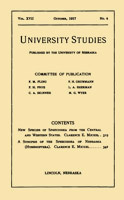University Studies of the University of Nebraska
Date of this Version
7-1976
Citation
Oseto, C.Y., and T. J. Helms, Anatomy of the Adults of Loxagrotis Albicosta, University of Nebraska Studies, new series no. 52, July 1976. 136 p.
Abstract
LEPIDOPTERA are divided into the major suborders Monotrysia and Ditrysia (Borner, 1939). The vast majority of Lepidoptera belong to the Ditrysia. The Noctuidae, which is the largest family in the order, is probably the most destructive (Metcalf, et aI., 1962). It includes Loxagrotis albicosta (Smith), the western bean cutworm, originally a pest of field beans, which has become a relatively serious pest of corn in southwestern and central Nebraska (Hagen and Roselle, 1972). Adults emerge from early July to late August, and eggs, which are deposited on the upper sides of corn leaves, hatch in approximately I week. The newly emerged larvae feed on pollen of the developing tassels or after tassel emergence will feed on the silks. There are 5 larval instars, with the 4th and 5th instars feeding on the developing kernels until larval maturity. Mature larvae enter the soil and overwinter as pre pupae in earthen cells and pupate during late May (Hagen, 1962). Although the life history of L. albicosta is known, other aspects of its biology have not been reported. This study is an attempt to present details of the external structure of L. albicosta. No extensive treatment of noctuid anatomy is available; however, there does exist an enormous body of knowledge concerning structural details in the various species of Lepidoptera. But that knowledge is for the most part weakly coordinated. Basic studies of this nature should be the prerequisite to investigations in the diverse areas of entomology.
Included in
Agriculture Commons, Arts and Humanities Commons, Entomology Commons


Comments
(c) 1976 by the Board of Regents of the University of Nebraska